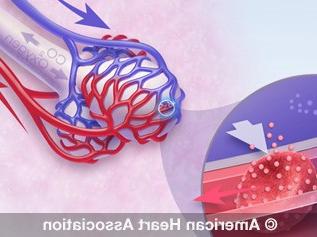儿童和青少年心力衰竭

这个词 心脏衰竭 形容心脏功能不正常. It does not mean that the heart has stopped working but instead that it isn’t working as well as it should.
由于吸烟的影响,成年人会发生心力衰竭, 高血压, 糖尿病和冠心病. 由于其他原因,它可能发生在新生儿、婴儿、幼儿和青少年身上.
因为心力衰竭有不同的原因, 重要的是要认识到它是如何诊断的, 在更年幼的儿童中得到治疗甚至治愈. 但要了解儿童心力衰竭的表现, 首先了解心脏应该如何工作是很重要的.
健康的心脏
心脏是一个泵. 它的泵送功能是由内部电气系统启动的. A healthy heart is cleanly divided into a right and left side, each with an upper and lower section. All of these compartments have an important job in helping circulate blood carrying the oxygen we breathe to the body by moving it through the heart and lungs in a certain order and direction.
一堵墙, 叫做隔膜, separates the two sides of the heart so that the blood with oxygen from the lungs and the blood without oxygen do not mix. Valves help the heart’s sides and sections circulate blood in the heart in the right direction to move oxygen-poor blood to the lungs and move oxygen-rich blood to the rest of the body. 瓣膜的作用是防止血液在心脏内回流.
为了孩子的成长和发展, the heart needs to maintain normal pump function in order to provide effective 血液流动 throughout the body.
是什么导致儿童心力衰竭?
儿童心力衰竭最常见的原因是 先天性心脏缺陷,意思是出生时就有缺陷. 有时, certain medical disorders can cause children to develop heart defects or can damage a child’s heart, 会导致心力衰竭.
儿童心力衰竭的类型
Over-circulation失败
Some 先天性心脏缺陷 that can cause 心脏衰竭 in children include those that interrupt the clean division of the heart’s chambers. 这些缺陷会中断正常的心脏血流, 也就是说心脏不能正常循环血液. 这些缺陷会导致一种称为过度循环衰竭的心力衰竭, which is when oxygenated and de-oxygenated blood mix inside the heart rather than remaining separate to circulate through the body properly. 这些缺陷包括:
- 左、右、上、下腔之间的洞.
- 不正确形成的心室.
- 大动脉缺陷.
- 心脏瓣膜渗漏或变窄.
泵故障
Some medical conditions can cause a child’s heart to develop incorrectly or become damaged. 这导致心脏不能有效地泵血,这被称为泵血衰竭.
泵故障可由以下原因引起:
- 一种破坏正常心肌的病毒或细菌感染.
- 心脏供血减少(儿童少见).
- 治疗其他疾病如癌症的药物.
- 不规则的心跳, which happen when the heart’s electrical system is either abnormal from birth or damaged by infection, 导致心脏跳动过慢或过快.
- 心脏瓣膜瓣膜不能正常打开或关闭的缺陷, 导致心脏腔内的压力回升.
- 患有肌肉萎缩症等健康问题的儿童, Kawasaki disease or specific genetic disorders can eventually also develop problems with the heart muscle.
体征和症状
婴儿
婴儿心力衰竭的症状和体征包括:
- 呼吸困难.
- 可怜的喂养.
- 可怜的增长.
- 过度出汗.
- 足部、脚踝、小腿、腹部、面部或颈部肿胀.
通常,患有心力衰竭的婴儿会:
- 进食线上电子游戏飞禽走兽较长或在短线上电子游戏飞禽走兽内对进食不感兴趣.
- Have a rapid heartbeat that can be felt through the chest wall when the infant is sleeping or resting.
- 不能以健康的速度增加体重.
- 呼吸急促或困难.
孩子们
患有心力衰竭的儿童和青少年可以:
- Become tired quickly, especially if a viral infection has caused heart muscle damage.
- 晚上排尿更频繁.
- 失去食欲.
- 咳嗽.
- 心律不齐.
- 脚、脚踝或腹部肿胀.
- 增加体重.
- 感到呼吸急促.
诊断
检查
如果怀疑您的孩子有心力衰竭, 您的孩子的健康护理专业人员将检查他们:
- 呼吸急促或吃力.
- 足部,脚踝和腹部肿胀.
- 颈静脉突出.
- 孩子肺部因积液而发出噼啪声.
- 不规则的心跳或心音.
Your child’s health care professional might also take a blood sample from your child to send to a lab to look for signs of 心脏衰竭.
成像
If your child’s physician suspects that your child might be experiencing 心脏衰竭, 他们会安排成像检查你孩子的心脏.
成像包括:
Your child could be referred to a pediatric heart specialist for imaging or for additional tests, 但成像通常在儿科医生的办公室或诊所进行. 成像并不痛苦. 然而, 取决于你孩子的年龄和合作能力, 为了获得最清晰的结果,轻度镇静可能是必要的.
测试
有时,可能需要心导管. 在这个测试中, 一个小塑料管, 叫做导管, 是从孩子的腿或手臂的血管中植入心脏的吗. The catheter is used to record pressures and the amount of oxygen in the different parts of the heart. Because this test is performed in a special catheterization procedure room or laboratory, 短期住院往往是必要的.
如何治疗小儿心力衰竭?
处理过循环故障
通常,过度循环衰竭可以通过药物治疗来控制. 有时, your child’s health care professional might initially treat your child with medications that require hospitalization. 这些药物包括利尿剂(水丸)和后负荷减压剂, 哪一种方法可以帮助你的孩子排出过多的心脏容积, lower blood pressure resistance and improve the heart’s ability to circulate blood.
Your health care professional might consider nutritional supplements to help your child get enough calories to offset the effects of over-circulation.
然而, the defect causing your child’s 心脏衰竭 might be too difficult to manage with medications and nutritional changes. Surgery is often necessary to repair the defect causing over-circulation failure. 如果需要做心脏手术, you will have the opportunity to discuss the types of surgery or other treatments that are available with your child’s health care professional.
泵故障处理
如果你孩子的心脏衰竭是由泵衰竭引起的, 可使用利尿剂和后负荷减压剂. 有时 other medications can be prescribed that lower blood pressure to help the heart pump better. 为了进一步改善心脏功能,住院治疗是必要的. At times, surgery can also be required, such as replacing a damaged heart valve.
由于心跳过慢导致的泵故障通常需要 起搏器. Pacemakers are implanted medical devices that help the heart maintain a normal heart rate. 小, battery-operated devices are tiny computers implanted under your child’s skin with a small wire connected to the heart. 这需要外科手术.
如果是心跳过快导致泵故障, 你的孩子可能需要药物来控制心跳. 在其他时候, a specialized heart catheterization procedure called radiofrequency ablation might be recommended to correct the abnormal heart rhythm. This procedure applies short bursts of radio waves to the area of heart muscle causing the rapid heartbeat.
很少, 如果泵故障是由不可逆的肌肉损伤引起的, heart function could not improve with medication and could continue to worsen. 在这种情况下,一个特殊的起搏器, 机械泵 (LVAD) or an extracorporeal membrane oxygenator (ECMO) might be necessary to improve heart pump function temporarily. 如果治疗后心肌功能继续恶化, 你的心脏专家可能会和你讨论心脏移植的必要性.
乐观的空间
虽然心脏衰竭可能发生在任何孩子身上, 这是非常罕见的,并不是没有希望的情况. 儿童心力衰竭的许多原因是可以修复或控制的. It’s important that parents and family members understand the causes and treatments of 心脏衰竭 in children.
当父母确保提供适当的医疗照顾时, 随着新技术和药物的出现, most children with 心脏衰竭 should be able to grow and lead active lives.






